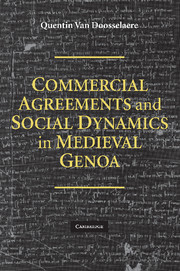Book contents
- Frontmatter
- Contents
- List of Figures
- List of Tables
- Abbreviations
- Acknowledgments
- 1 From Sword into Capital
- 2 Genoa at the Dawn of the Commercial Expansion
- 3 Equity Partnerships for Heterogeneous Ties
- 4 Credit Network for Routinized Merchants
- 5 Insurance Ties for Oligarchic Cohesion
- 6 Conclusion
- Appendix A Sample of Prices and Income
- Appendix B Sample of Long-Distance Trade Participants' Occupations
- Appendix C Commenda Network Graphs
- Appendix D Nodal Degree Distributions of Commenda Networks
- Appendix E List of Top Mercantile Nonaristocratic Families
- Appendix F Partner Selection Probability Model
- Bibliography
- Index
5 - Insurance Ties for Oligarchic Cohesion
Published online by Cambridge University Press: 31 August 2009
- Frontmatter
- Contents
- List of Figures
- List of Tables
- Abbreviations
- Acknowledgments
- 1 From Sword into Capital
- 2 Genoa at the Dawn of the Commercial Expansion
- 3 Equity Partnerships for Heterogeneous Ties
- 4 Credit Network for Routinized Merchants
- 5 Insurance Ties for Oligarchic Cohesion
- 6 Conclusion
- Appendix A Sample of Prices and Income
- Appendix B Sample of Long-Distance Trade Participants' Occupations
- Appendix C Commenda Network Graphs
- Appendix D Nodal Degree Distributions of Commenda Networks
- Appendix E List of Top Mercantile Nonaristocratic Families
- Appendix F Partner Selection Probability Model
- Bibliography
- Index
Summary
In previous chapters, I have indicated that in medieval Europe, traveling risks dwarfed the strictly commercial risks of long-distance ventures. Thus, the emergence of maritime insurance contracts during the second part of the fourteenth century directly responded to an economic need, and freed investment capital. This said, in this chapter, I continue the analysis of the role of commercial institutions in the transformation of Genoa's social organization by showing that the maritime insurance market was not sustained by commercial interests alone. Indeed, although the key innovation of medieval insurance was the ability to transfer traveling risk to a third party, underwriting took place inside the mercantile community; more than the price mechanism, it was the expectation of social reciprocity that organized the insurance pairings. In fact, I demonstrate that underwriting decisions were laced with solidaristic meaning and that insurance became more than an economic tool as it cemented the robustness of the Genoese oligarchic network.
This fifth chapter differs slightly from the previous two. The first difference relates to the unit of analysis. Earlier chapters analyzed ties among individuals from which larger social aggregates were formed. This focus corresponded to the commercial reality that linked individual interests together. However, the intense social consolidation of the mercantile Genoese elite into clusters of households called alberghi during the fourteenth and early fifteenth centuries profoundly altered the nature of intrafamily ties and had far-reaching implications for the social organization of the city.
- Type
- Chapter
- Information
- Commercial Agreements and Social Dynamics in Medieval Genoa , pp. 170 - 207Publisher: Cambridge University PressPrint publication year: 2009

